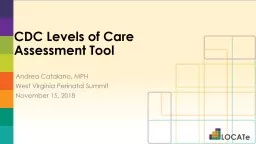/


CDC Levels of Care Assessment Tool Andrea Catalano MPH West Virginia Perinatal Summit November 15 2018 Background RiskAppropriate Care Strategy promoted in 1976 March of Dimes report Simple concept quickly embraced by many states ID: 774248
Download Presentation The PPT/PDF document "CDC Levels of Care Assessment Tool" is the property of its rightful owner. Permission is granted to download and print the materials on this web site for personal, non-commercial use only, and to display it on your personal computer provided you do not modify the materials and that you retain all copyright notices contained in the materials. By downloading content from our website, you accept the terms of this agreement.
CDC Levels of Care Assessment Tool Andrea Catalano, MPH West Virginia Perinatal SummitNovember 15, 2018
Background
Risk-Appropriate Care Strategy promoted in 1976 March of Dimes report*Simple concept quickly embraced by many states Enhanced byPublic health researchImplementation complicated by Reimbursement policies Hospital competitionRegional context * Committee on Perinatal Health. Toward Improving the Outcome of Pregnancy:Recommendations for the Regional Development of Maternal and Perinatal Health Services. White Plains, NY: March of Dimes National Foundation, 1976.
Policy Based on Guidance Challenges Reimbursement, competition, landscapeLack of granularity = Inconsistent policiesAAP guidelines + X/Y/Z = State policy A/B/C *Absence of maternal level criteria comparable to neonatal (Until 2015**) * Blackmon LR, Barfield WD, Stark AR. Hospital neonatal services in the United States: variation in definitions, criteria, and regulatory status, 2008. J Perinatol. 2009 Dec;29(12):788-94 ** Levels of maternal care. Obstetric Care Consensus No. 2. American College of Obstetricians and Gynecologists. Obstet Gynecol 2015;125:502–15
A Perfect Storm
What is LOCATe ? Levels of Care Assessment Tool Produces standardized assessmentsFosters collaboration across borders Strengthens evidence for increased specificity in criteria3) Facilitates stakeholder conversationsIncreases (common) understanding of landscape Data driven improvements in facilities & systems…while, minimizing burden on respondents
Development of LOCATe 2013-Pilot testing Several facilities in 5 states 2014-Field testingAll facilities in 2 states, initially Then, staged roll-out with additional states2017-Version 8Each state implementation provides feedbackV8 includes: Questions on drills & protocols More refined wording
LOCATe Content
LOCATe Content Includes questions about: Hospital equipment and staffingSubspecialists and their availability Self-designation of level of care Volume of procedures Pediatric Surgery Ventilation for neonatesTransports and facility-level statistics
The LOCATe Process
The LOCATe Process
The LOCATe Assessment
LOCATe Jurisdictions* *as of 11/2018
Analysis & Dissemination
Analysis Opportunities State level reportSummary of guidelines Aggregate information by levelsMerge levels with public health surveillance dataHospital discharge records (Severe Maternal Morbidity and neonatal morbidity) Vital Records (neonatal and post neonatal mortality)Examine outcomes between and within levels of care and by specific capabilities
Dissemination Opportunities Webinar for HospitalsHigh-level information & overview Individual Hospital ReportsDescribe facility’s levels and reasons for variation from expected levelsDiscuss quality improvement opportunities Patient safety bundles Partner with other organizations to strategize activities on risk-appropriate care in state/jurisdiction
Future Activities Multi-jurisdiction analysis LOCATe toolkit ACOG Levels of Maternal Care Verification ProgramMore Technical Assistance Materials Emergency preparedness Quality Improvement Opportunities for telemedicine use
Thank you! Questions? Andrea Catalano acatalano@cdc.gov The findings and conclusions in this report are those of the authors and do not necessarily represent the official position of the Centers for Disease Control and Prevention.